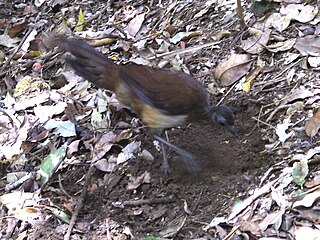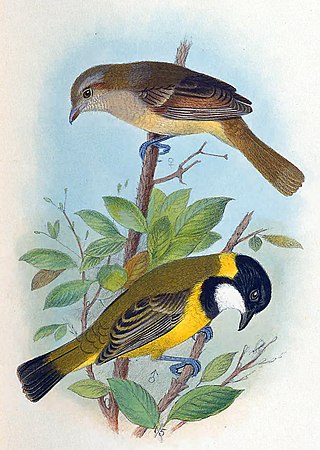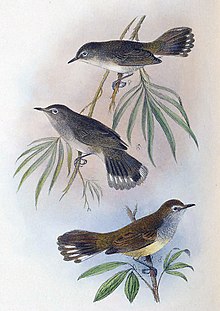
The pied currawong is a black passerine bird native to eastern Australia and Lord Howe Island. One of three currawong species in the genus Strepera, it is closely related to the butcherbirds and Australian magpie of the family Artamidae. Six subspecies are recognised. It is a robust crowlike bird averaging around 48 cm (19 in) in length, black or sooty grey-black in plumage with white undertail and wing patches, yellow irises, and a heavy bill. The male and female are similar in appearance. Known for its melodious calls, the species' name currawong is believed to be of indigenous origin.

The white swamphen, also known as the Lord Howe swamphen, Lord Howe gallinule or white gallinule, is an extinct species of rail which lived on Lord Howe Island, east of Australia. It was first encountered when the crews of British ships visited the island between 1788 and 1790, and all contemporary accounts and illustrations were produced during this time. Today, two skins exist: the holotype in the Natural History Museum of Vienna, and another in Liverpool's World Museum. Although historical confusion has existed about the provenance of the specimens and the classification and anatomy of the bird, it is now thought to have been a distinct species endemic to Lord Howe Island and most similar to the Australasian swamphen. Subfossil bones have also been discovered since.

The Lord Howe woodhen also known as the Lord Howe Island woodhen or Lord Howe (Island) rail, is a flightless bird of the rail family, (Rallidae). It is endemic to Lord Howe Island off the Australian coast. It is currently classified as endangered by the IUCN.

The Australian hobby, also known as the little falcon, is one of six Australian members of the family Falconidae. This predominantly diurnal bird of prey derives its name ‘longipennis’ from its long primary wing feathers. It occurs throughout Australia and other neighbouring countries with migrating individuals found on the islands of Indonesia and New Guinea.

Albert's lyrebird is a timid, pheasant-sized songbird which is endemic to subtropical rainforests of Australia, in a small area on the state border between New South Wales and Queensland. The rarer of the two species of lyrebirds, Albert's lyrebird is named after Prince Albert, the prince consort of Queen Victoria, queen of the United Kingdom. It lacks the elegant lyre-shaped tail feathers of the superb lyrebird and is found in a much more restricted range.

The weebill is a species of bird in the family Acanthizidae. It is an insectivorous passerine that is found throughout mainland Australia. At 8 to 9 cm long, it is Australia's smallest bird. It was originally described by John Gould in 1838, and four subspecies are recognised. The weebill's plumage is nondescript, with olive-grey upperparts and paler, more yellowish underparts. It grades from more brownish plumage in the southern regions of Australia to more yellow in tropical areas.
The Tasman starling was described in 1836 by John Gould as a species which occurred on both Norfolk Island and Lord Howe Island. In 1928 Australian ornithologist Gregory Mathews recognized that the plumage of the race from Lord Howe Island was much browner and more greyish than the plumage of the Norfolk Island race and split the species into two forms, the Norfolk starling, and the Lord Howe starling. Both subspecies are now extinct, thus so the species.

The Christmas imperial pigeon or Christmas Island imperial pigeon, also known as Black imperial pigeon, Dusky imperial pigeon, Wharton's imperial pigeon, or burong pergam, is a large imperial pigeon endemic to Christmas Island in the northeastern Indian Ocean. It has an overall grey-blue colouration, and juveniles are duller than adults. It makes a soft purring coo sound and a deeper whoo sound comparable to a cow mooing. It lays one glossy white egg per brood, and is possibly somewhat colonial.

The green rosella or Tasmanian rosella is a species of parrot native to Tasmania and Bass Strait islands. It was described by the German naturalist Johann Friedrich Gmelin in 1788, and named on the mistaken assumption it came from New Caledonia. At 14.5 in (37 cm) long it is the largest species of the rosella genus, Platycercus. Two subspecies are recognised. The green rosella's underparts, neck and head are yellow, with a red band above the beak and violet-blue cheeks. The back is mostly black and green, and its long tail blue and green. The sexes have similar plumage, except the female has duller yellow plumage and more prominent red markings, as well as a smaller beak. Juvenile and immature birds have predominantly green plumage.

The brown gerygone, previously known as the brown warbler, is a small passerine bird native to eastern coastal Australia. The upper parts of the brown gerygone are a deep olive-grey or olive-brown, while its face and underparts are a much paler grey, cream, or washed-out brown. The tail feathers are dark and may be white-tipped. It is approximately 10 cm in length.

The Chatham gerygone or Chatham Island warbler is a species of bird in the family Acanthizidae. It is endemic to the Chatham Islands. The Chatham Island warbler is larger than and differs in plumage from the related grey warbler of mainland New Zealand. Both warblers were discovered and named by G. R. Gray in 1845. The grey and Chatham Island warblers are the only two members of the Australasian family Acanthizidae found in New Zealand.

Gerygone, the gerygones or peep-warblers, is a genus of bird in the family Acanthizidae. The genus ranges from Southeast Asia through New Guinea and Australia to New Zealand and the Chatham Islands. Most of the species are found in Australia and New Guinea; only one, the golden-bellied gerygone, has managed to cross Wallace's Line and colonise as far as Thailand, Malaysia and the Philippines.

The western gerygone is a small, brownish-grey species of passerine bird, which is found in inland and south-west Australia. It is an arboreal, insectivore of open forest, woodland and dry shrubland. It is not currently threatened with extinction.

Acanthizidae—sometimes called Australian warblers—are a family of passerine birds which includes gerygones, thornbills Acanthiza, and scrubwrens Sericornis. The family Acanthizidae consists of small to medium passerine birds, with a total length varying between 8 and 19 centimetres. They have short rounded wings, slender bills, long legs, and a short tail. Most species have olive, grey, or brown plumage, although some have patches of a brighter yellow. The weebill is the smallest species of acanthizid, and the smallest Australian passerine; the largest is the pilotbird.

The New Zealand fantail is a small insectivorous bird, the only species of fantail in New Zealand. It has four subspecies: R. f. fuliginosa in the South Island, R. f. placabilis in the North Island, R. f. penita in the Chatham Islands, and the now-extinct R. f. cervina formerly on Lord Howe Island. It is also known by its Māori names, pīwakawaka, tīwakawaka or piwaiwaka, and the Chatham Island subspecies by the Moriori name tchitake; the common pied morph is also known as pied fantail, and the uncommon dark morph is also known as black fantail. The species has been considered by many to be conspecific as the grey fantail of Australia and New Caledonia; however, due to significant differences in its calls, many authorities now treat it as a separate species.

SS Makambo was a steamship first owned by Burns Philp & Co. Ltd. She was built in Port Glasgow in Scotland and named after an island in the Solomon Islands. She carried both passengers and cargo and was principally used on routes between eastern Australia and islands in Melanesia and the Tasman Sea. In November 1908 Jack and Charmian London travelled from Guadalcanal to Sydney on the Makambo after abandoning their ill-fated circumnavigation of the world on the Snark, a 45' sailing yawl.

The Lord Howe golden whistler, also known as the Lord Howe whistler or Lord Howe Island golden whistler, and locally as the “robin” or “yellow robin”, is a small bird in the whistler family, Pachycephalidae. It is a subspecies of the Australian golden whistler that is endemic to Lord Howe Island in the Tasman Sea, part of New South Wales, Australia.

The grey warbler, also known by its Māori name riroriro or outside New Zealand as the grey gerygone, is an insectivorous bird in the family Acanthizidae endemic to New Zealand. Its natural habitat is temperate forests. It is sometimes known as the teetotum or rainbird.


















